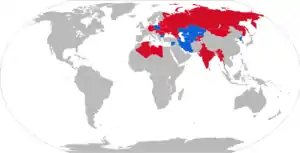S-200 (missile)
The NPO Almaz S-200 Angara/Vega/Dubna (Russian С-200 Ангара/Вега/Дубна), NATO reporting name SA-5 Gammon (initially Tallinn),[2] is a very long range, medium-to-high altitude surface-to-air missile (SAM) system designed in the 1960s to defend large areas from bomber attack or other strategic aircraft. Each battalion has 6 single-rail missile launchers for the 10.8 m (35 ft) long missiles and a fire control radar. It can be linked to other, longer-range radar systems.
| S-200 Dubna SA-5 Gammon | |
|---|---|
 S-200 missile (Vega) on its launcher | |
| Type | Strategic SAM system |
| Place of origin | Soviet Union |
| Service history | |
| In service | 1967–present |
| Used by | See list of present and former operators |
| Wars | First Libyan Civil War Syrian Civil War |
| Production history | |
| Designer | KB-1 design bureau (system), GSKB Spetsmash (launcher)[1] |
| Designed | 1964 |
| Variants | S-200, S-200V (S-200VE), S-200D (S-200DE), S-200A |
| Specifications | |
Guidance system | Semi-active radar homing |
Description
_missile_of_surface-to-air_missile_system_%C2%ABDal%C2%BB_in_Military-historical_Museum_of_Artillery%252C_Engineer_and_Signal_Corps_in_Saint-Petersburg%252C_Russia.jpg.webp)
The S-200 surface-to-air missile system was designed for the defense of the most important administrative, industrial and military installations from all types of air attack. S-200 provides defeat of modern and advanced aircraft, including air command and control centers, AWACS aircraft, aircraft jamming creation and other manned and unmanned aerial vehicles. The S-200 is an all-weather system that can be operated in various climatic conditions.[3]
By 1966, the S-200 was officially accepted into service in order to replace the failed anti-ballistic missile RZ-25/5V11 "Dal". The Dal was assigned the NATO reporting name SA-5 "Griffon" before it was cancelled.
The first S-200 operational regiments were deployed in 1966 with 18 sites and 342 launchers in service by the end of the year. By 1968 there were 40 sites, and by 1969 there were 60 sites. The growth in numbers then gradually increased throughout the 1970s (1,100 launchers)[4] and early 1980s until the peak of 130[1] sites and 2,030 launchers was reached in 1980–1990.[4]
Missiles
| 5V21 | |
|---|---|
| Type | Surface-to-air missile |
| Place of origin | Soviet Union |
| Service history | |
| In service | 1967–present |
| Used by | See list of operators |
| Production history | |
| Designer | OKB-2 design bureau (missile), SKB-35 bureau (avionics), NII-125 research institute (solid rocket fuel) |
| Variants | 5V21, 5V28, 5V28V |
| Specifications (5V28V[1]) | |
| Mass | 7,100 kg (15,700 lb) |
| Length | 10.8 m (35 ft) |
| Warhead | Frag-HE |
| Warhead weight | 217 kg (478 lb) |
Detonation mechanism | proximity and command fusing[5] |
| Propellant | dual-thrust liquid-fueled rocket motor |
Operational range | 300 kilometres (190 mi)[6] |
| Flight altitude | 40,000 metres (130,000 ft) |
| Boost time | 4 solid-fueled strap-on rocket boosters |
| Maximum speed | Mach 4 (4,900 km/h; 3,045 mph)[6] |
Guidance system | semi-active radar homing seeker head |
Each missile is launched by 4 solid-fueled strap-on rocket boosters.[7] After they burn out and drop away (between 3 and 5.1 seconds from launch) it fires a 5D67 liquid fueled sustainer rocket engine (for 51–150 seconds) which burns a fuel called TG-02 Samin (50% xylidine and 50% triethylamine), oxidized by an agent called AK-27P Melange (red fuming nitric acid enriched with nitrogen oxides, phosphoric acid and hydrofluoric acid).[8] Maximum range is between 150 km (81 nmi) and 300 km (160 nmi), depending on the model.[9] The missile uses radio illumination mid-course correction to fly towards the target with a terminal semi-active radar homing phase. Maximum target speed is around Mach 6 for new model and Mach 4 for earlier model. Effective altitude is 300 m (980 ft) to 20,000 m (66,000 ft) for early models and up to 35,000 m (115,000 ft) for later models. The warhead is either 217 kg (478 lb) high-explosive fragmentation (16,000 × 2 g fragmentation pellets and 21,000 × 3.5 g pellets) triggered by radar proximity fuse or command signal, or a 25 kt nuclear warhead triggered by command signal only. Each missile weighs around 7,108 kg (15,670 lb) at takeoff.[9]
The system utilises radio semi active guidance throughout the missile's flight, which is far more accurate at long range than the command guidance method used by the earlier S-75 Dvina and other missiles. The existence of an optional terminal passive radar homing mode for use against airborne early warning (AEW) aircraft remains unconfirmed. Peak missile speed is around Mach 8 and the single-shot kill probability is quoted as 0.85, presumably against a high altitude bomber-type target.
Main radar system
The fire control radar of the S-200 system is the 5N62 (NATO: Square Pair) H band continuous wave radar, whose range is 270 km (170 mi). It is used for both the tracking of targets and their illumination.
Additional radar systems
- P-14/5N84A "Tall King" A-band early warning radar (range 600 km (370 mi), 2–6 RPM, maximum search altitude 46 km (29 mi) ) or 5N69 Salute "Big Back" E-band early warning radar 600 km (370 mi)
- Kabina 66 "Back Net" or 5N87 "Back Trap" E-band early warning radar (with special low-altitude search mod, range 370 km (230 mi), 3–6 RPM)
- P-35/37 "Bar Lock/Bar Lock B" 1,000 kW E/F-band target detection and tracking radar (with integrated IFF, range 392 km (244 mi), 7 RPM)
- PRV-11 "Side Net" or PRV-13 "Odd Pair" E-band height finding radar (also used by the SA-2, SA-4 and SA-6, range 240 km (150 mi), 3–6 RPM)
- P-15M(2) "Squat Eye" 380 kW C-band target detection radar (range 128 km (80 mi)
Versions
- S-200A "Angara" (SA-5a), with the V-860/5V21 or V-860P/5V21A missile, introduced in 1967, range 17-180 km (110 mi), ceiling 20 km (12 mi)/0.5–40. The probability of hitting the target 0.45–0.98[10]
- S-200V "Vega" (SA-5b), with the V-860PV/5V21P missile, introduced in 1970, range 240 km (150 mi) minimum 7 km, ceiling 29 km (18 mi) superior limit 35,[3] minimum height 0,05 km. Five divisions. Division – one goal and missiles at targets a maximum of 2. Missile has a semi-active radar homing. The launch – reclining, with a constant angle of elevation, from the launcher, is rotated horizontally.[3]
- S-200 "Vega" (SA-5b), with the V-870 missile, range increased to 300 km (190 mi) and ceiling to 40 km (25 mi) with the new, shorter missile and solid fuel motor. The probability of hitting the target 0.66–0.99.
- S-200M "Vega-M" (SA-5b), with the V-880/5V28 or V-880N/5V28N² missile, range 300 km (190 mi), ceiling 29 km (18 mi)
- S-200VE "Vega-E" (SA-5b), with the V-880E/5V28E missile, export version, high-explosive warhead only, range 240 km (150 mi) Minimum target size of 0.3 sq. meters. Speed of the target -1200 m / s [11][12] The number of simultaneously fired targets. Up to 5 (the number of radar targeting). Greater than previously opportunity fight against stealth.[11]
- S-200D "Dubna" (SA-5c), with the 5V25V, V-880M/5V28M or V-880MN/5V28MN² missile, introduced in 1976, high-explosive or nuclear warhead, range 300 km (190 mi), ceiling 0,3-40 km (25 mi). The probability of hitting the target 0,72-0,99.[10]
Command post S-300 (SA-20/SA-20A/SA-20B) can manage in any combination the elements of S-200 and S-300.[13][14] Missiles complex S-200 Dubna can be controlled command post system S-300,[14] command post S-300 may also be controlled[15] by the command post S-400 (S-200 Dubna still have in service)[12] Or through a higher-level command post (Organize Use PVO 73N6 "Baikal-1").[16]
Iranian air defense force has implemented several improvements on their S-200 systems such as using solid state parts and removing restrictions on working time. They destroyed a UAV target beyond 100 km range in military drill in recent years.[17] They use two new solid propellant missile named Sayyad-2 and Sayyad-3 via interface systems Talash-2 and Talash-3 in cooperation with S-200 system. These missiles can cover medium and long ranges at high altitudes.[18][19]
Also, Iran claims to have developed a mobile launcher for the system.[20]
Operational history
Libya
Starting in 1985, Libya received a number of S-200 missile systems.[21] In the following months, Libyan forces fired a number of S-200 missiles in different occasions at US fighter-bombers, missing them.[22] In the USSR, three organizations (CDB Almaz, a test site and a research institute of the Ministry of Defense) conducted computer simulation of the battle, which gave the probability of hitting each of the air targets (3) in the range from 96 to 99%.[23][24]
Syria
Starting in January 1983, Syria received supplies of S-200 missiles from the Soviet Union.[25] They were organized into two long range surface to air missile regiments, each composed of two battalions of two batteries each for a total of at least 24 launchers. Later in the 1980s, the Soviet Union agreed to supply a third regiment increasing the number of launchers to 40–50. Initially the missiles were manned by Soviet crews,[26] later they were transferred to Syrian control. As such, Syria became the first country outside the Soviet Union to field the S-200 system.[27]
During the initial years of the Syrian Civil War, parts of the S-200 systems were occasionally spotted when Syrian Air Defense Force sites were overrun by rebel forces. Most notably radars, missiles and other equipment from S-200 systems was pictured in a state of disrepair when rebels overtook the air defense site in Eastern Ghouta in October 2012.[28][29] On 2 January 2017, the Syrian Army re-captured this air defense base.[30]
Starting with the Russian intervention in the civil war in late 2015, there were new efforts to restore some Syrian S-200 systems. Indeed, on 15 November 2016, the Russian defence minister confirmed that Russian forces repaired Syrian S-200s to operational status.[31] For example, in July 2016, the Syrian Army, with Russian assistance, rebuilt an S-200 site at Kweires airport, near Aleppo.[32][33] On September 12, 2016, the Israel Defense Forces confirmed that two Syrian S-200 missiles were fired at Israeli aircraft while they were on a mission inside Syrian airspace. The Syrian Defense Ministry claimed that an Israeli jet and a drone were shot down.[34] According to the IDF spokesman's office, the claims are "total lies," and "at no point was the safety of IDF aircraft compromised." [35]
On March 17, 2017, the Israeli Air Force attacked a number of Syrian armed forces targets near Palmyria in Syria. Four Israeli aircraft flew through Lebanese territory and launched Popeye stand off missiles with a range of 78 km[36] toward Syrian territory. Syrian Air defence force (SyADF) after some time alerted one S-200V (SA-5) missile battery and tried to retaliate, 2 out of 4 attacking jets were illuminated with two 5N62 Fire Control Radars and missiles were fired on 2 targets, which then were over southern Lebanon.[37] During the action a number of Syrian S-200 missiles were fired at the Israeli aircraft.[38] One of the Syrian missiles, going ballistic after losing its target, was inbound to a populated area in Israel. The Israeli missile defense fired at least one Arrow missile which intercepted the incoming missile.[39] Two other S-200 missiles landed in other parts of Israel, having lost their target. According to ANNA News, Syria claimed that they had shot down one IAF F-16 aircraft and damaged another.[40][38] While the Syrian Defense Ministry claimed that an Israeli fighter jet was shot down, which was denied by Israel, Israeli defence minister Avigdor Lieberman threatened to destroy Syrian air defence systems after they fired ground-to-air missiles at Israeli warplanes carrying out strikes.[41] The Jordanian armed forces reported that parts of a missile fell in its territory. There were no casualties in Jordan.[42]
On October 16, 2017, a Syrian S-200 battery located around 50 kilometers east of Damascus fired a missile at an Israeli Air Force surveillance mission over Lebanon. The IAF responded by attacking the battery and destroying the fire control radar with four bombs.[43][44][45] Despite this, the Syrian Defense Ministry said in its statement that the air-defense forces "directly hit one of the jets, forcing [Israeli aircraft] to retreat." Israel said that no plane was hit.
On February 10, 2018, Israel launched an air strike against targets in Syria with eight fighter aircraft as retaliation for a UAV incursion into Israeli airspace earlier in the day. Syrian air defenses succeeded in shooting down one of the Israeli jets, an F-16I Sufa, with an S-200 missile - this was the first Israeli jet to be shot down in combat since 1982.[46][47] The jet crashed in the Jezreel Valley, near Harduf.[48] Both the pilot and the navigator managed to eject, one was injured lightly and the other was injured more seriously, but both survived and walked out of hospital one week later.[49][50]
On 10 May 2018, Israeli Air Force launched Operation House of Cards against a number of Iranian and Syrian targets, claiming the destruction of a S-200 radar among different other targets.[51]
On September 17, 2018, a Russian Il-20M ELINT plane was shot down by a Syrian S-200 surface-to-air missile. Four Israeli F-16 fighter jets attacked targets in Syria's Latakia with standoff missiles, after approaching from the Mediterranean Sea, a statement by the Russian defense ministry said on 18 September. “The Israeli pilots used the Russian plane as cover and set it up to be targeted by the Syrian air defense forces. As a consequence, the Il-20, which has radar cross-section much larger than the F-16, was shot down by an S-200 system missile,” the statement said. The Russian ministry stressed that the Israelis must have known that the Russian plane was present in the area, which didn't stop them from “the provocation”. Israel also failed to warn Russia about the planned operation in advance. The warning came a minute before the attack started, which “did not leave time to move the Russian plane to a safe area,” the statement said. On 21 September, an Israeli delegation visiting Moscow stated that the Israeli attack formation did not use the Russian Il-20 as a shield during the attacks, while blaming the incident on the Syrian Air Defense Force which fired missiles for forty minutes while the Israeli attack formation had already left the area.[52][53] Russian President Vladimir Putin downplayed the incident saying that "it looks accidental, like a chain of tragic circumstances".
On 1 July 2019, a stray S-200 missile fired from Syria, presumably during bombing raids there, hit Northern Cyprus. The missile hit the ground around 1 a.m. near the village of Taşkent, also known as Vouno, some 20 kilometers (12 miles) northeast of Nicosia. The missile that hit Cyprus was a Russian-made S-200, said the Turkish Cypriot foreign minister.[54]
Operators

Current operators
 Algeria – 10
Algeria – 10 Azerbaijan – 15
Azerbaijan – 15 Bulgaria – [1] 1[55] battalion.
Bulgaria – [1] 1[55] battalion. India – 3 Battalions in Army, 4 Groups (Battalions) in the Indian Air Force[1]
India – 3 Battalions in Army, 4 Groups (Battalions) in the Indian Air Force[1] Iran – [1] 10 Upgraded battalions,[56][57] in service. Will be replaced by Sayyad-2/Sayyad-3 (Talash)system.[3]
Iran – [1] 10 Upgraded battalions,[56][57] in service. Will be replaced by Sayyad-2/Sayyad-3 (Talash)system.[3] Kazakhstan – [1]
Kazakhstan – [1] Myanmar - [58][59]
Myanmar - [58][59] North Korea – 4 battalions (2008).[1] 40 systems in 2010 (number of constituent elements is unknown).[60]
North Korea – 4 battalions (2008).[1] 40 systems in 2010 (number of constituent elements is unknown).[60] Poland – 2 squadrons.[1] Plan to replaced new anti aircraft systems Wisła.[61]
Poland – 2 squadrons.[1] Plan to replaced new anti aircraft systems Wisła.[61] Syria – 2 air defense regiments comprising 2 divisions including 2 S-200 batteries (44 launchers / ≈50[62]/ 48[63]) in service as of 2010,[64][65] S-200VE 48 launchers in 2012[66] Syrian Armed Forces constructed a new S-200 site at Kweires Airport, near Aleppo, in July 2016.[33] The system is operated by the Syrian Air Defense Force.
Syria – 2 air defense regiments comprising 2 divisions including 2 S-200 batteries (44 launchers / ≈50[62]/ 48[63]) in service as of 2010,[64][65] S-200VE 48 launchers in 2012[66] Syrian Armed Forces constructed a new S-200 site at Kweires Airport, near Aleppo, in July 2016.[33] The system is operated by the Syrian Air Defense Force. Turkmenistan – [1]
Turkmenistan – [1] Ukraine – Despite being retired in 2013, the S200 was brought back into Ukrainian Service.
Ukraine – Despite being retired in 2013, the S200 was brought back into Ukrainian Service.  Uzbekistan – [1]
Uzbekistan – [1]
Former operators
 Belarus – Approximately 4 battalions.[1]
Belarus – Approximately 4 battalions.[1] Czechoslovakia – 5 battalions, passed on to successor states.
Czechoslovakia – 5 battalions, passed on to successor states. Czech Republic – Inherited all Czechoslovak S-200 SAM systems, out of service since the mid 1990s.[1]
Czech Republic – Inherited all Czechoslovak S-200 SAM systems, out of service since the mid 1990s.[1] East Germany – 4 battalions.
East Germany – 4 battalions. Germany – 4 battalions former GDR, phased out around 1991
Germany – 4 battalions former GDR, phased out around 1991 Hungary – 1 battalion.[1]*
Hungary – 1 battalion.[1]*.svg.png.webp) Libyan Arab Jamahiriya – 8 battalions.[1]
Libyan Arab Jamahiriya – 8 battalions.[1] Moldova – [1] 1 Battalion
Moldova – [1] 1 Battalion Russia - No longer in service as of 2014
Russia - No longer in service as of 2014 Georgia – [1]
Georgia – [1] Mongolia – The Mongolian People's Army operated 4 battalions armed with SA-5 systems in 1985, but it is unlikely there are any operational as of 2011.[67]
Mongolia – The Mongolian People's Army operated 4 battalions armed with SA-5 systems in 1985, but it is unlikely there are any operational as of 2011.[67] Soviet Union – Originally deployed with the ZA-PVO in the strategic air defense role. It was phased out starting in the 1980s and passed on to the successor states before the phasing out process could be completed.[1]
Soviet Union – Originally deployed with the ZA-PVO in the strategic air defense role. It was phased out starting in the 1980s and passed on to the successor states before the phasing out process could be completed.[1]
Incidents involving the S-200
- Siberia Airlines Flight 1812: a Ukrainian S-200 operated by the Ukrainian military during a Ukrainian training exercise locked on to a Tupolev Tu-154 passenger aircraft flying from Tel Aviv to Novosibirsk. The airliner was destroyed over the Black Sea on 4 October 2001, killing all 78 people on board.[68]
- During Operation House of Cards Israeli Air Force targeted S-200.[69]
- During an Israeli airstrike against targets in Syria, an SA-5 fired by Syrian Air Defense missed the attacking Israeli aircraft and instead detonated over Vouno, Cyprus (roughly 225 km / 140 miles west of Syria). The missile caused a large fire on an unpopulated mountainside, which forced some nearby homes to be evacuated as a precaution. However, no civilians were killed or injured as a result of the missile impact. It was the first time during the Syrian Civil War that a missile fired from Syria impacted the island of Cyprus.[70]
See also
References
- "Almaz/Antei Concern of Air Defence S-200 Angara/Vega (SA-5 'Gammon') low to high-altitude surface-to-air missile system". Jane's Information Group. 2008-04-02. Retrieved 2008-08-15.
- Statement of Dr. John S. Foster, Director, Department of Research and Engineering, U.S. Department of Defense, April 15, 1970, p. 611.
- "C-200". Archived from the original on 16 September 2014. Retrieved 14 November 2014.
- "C-200". pvo.guns.ru. Archived from the original on 2014-11-27. Retrieved 2014-12-04.
- "S-200 SA-5 GAMMON". 1998-07-03. Archived from the original on 2008-04-21. Retrieved 2008-08-15.
- "S-200 SA-5 GAMMON - Russia / Soviet Nuclear Forces". Archived from the original on April 7, 2019. Retrieved Feb 21, 2019.
- "S-200 (SA-5 Gammon) | Missile Threat". Missile Threat. Archived from the original on 2018-03-07. Retrieved 2018-03-07.
- "Archived copy". Archived from the original on 2008-12-07. Retrieved 2009-01-23.CS1 maint: archived copy as title (link)
- "Archived copy". Archived from the original on 2009-02-27. Retrieved 2009-01-23.CS1 maint: archived copy as title (link)
- "Зенитный ракетный комплекс С-200В Вега - Ракетная техника". rbase.new-factoria.ru. Archived from the original on 2014-10-07. Retrieved 2014-12-04.
- "RusArmy.com - -200". Archived from the original on 19 October 2014. Retrieved 14 November 2014.
- "-200". Archived from the original on 24 September 2015. Retrieved 14 November 2014.
- "Средства управления 83М6Е2 - ОАО "НПО "Алмаз"". Archived from the original on 14 September 2014. Retrieved 14 November 2014.
- "-300 836". Archived from the original on 13 October 2014. Retrieved 14 November 2014.
- "ГСКБ Концерна ПВО Алмаз-Антей имени академика А.А. Расплетина (ОАО НИЭМИ) : с-25 беркут, бункин борис васильевич, с 300 пму, с-300 пму, зрс, с-400 триумф, средства пво, четырёхсотка, противовоздушная оборона". Archived from the original on 3 April 2014. Retrieved 14 November 2014.
- "736 "-1"". Archived from the original on 27 November 2014. Retrieved 14 November 2014.
- "اس-200 ایران؛ یک سورپرایز برای آواکس های دشمن + عکس". مشرق نیوز. 19 February 2012. Retrieved 23 January 2019.
- ""صیاد 2" زنجیره شکارچیان ایرانی را کامل کرد +عکس". mashreghnews.ir. 8 June 2014. Archived from the original on 26 August 2015. Retrieved 3 April 2018.
- "آشنایی با 3 سامانه پدافندی که ایران به جای اس 300 رونمایی کرد +عکس". 17 November 2014. Archived from the original on 20 November 2014. Retrieved 19 May 2015.
- "Iran upgrades S-200 long-range air defence system". Archived from the original on 29 November 2014. Retrieved 14 November 2014.
- https://warisboring.com/smoke-em/
- "EXCERPTS FROM NEWS SESSIONS ON CLASH WITH LIBYA'S FORCES". The New York Times. 25 March 1986. Archived from the original on 30 August 2017. Retrieved 29 August 2017.
- "Покорение "Ангары"". Archived from the original on 2017-07-03. Retrieved 2017-07-16.
- "C-200". pvo.guns.ru. Archived from the original on 2017-06-05. Retrieved 2017-07-16.
- "Soviet Is Said to Deploy New Missiles in Syria". Reuters. 18 January 1983. Archived from the original on 30 August 2017. Retrieved 29 August 2017 – via The New York Times.
- Times, Thomas L. Friedman and Special To the New York. "SYRIAN ARMY SAID TO BE STRONGER THAN EVER, THANKS TO SOVIET". nytimes.com. Archived from the original on 7 February 2018. Retrieved 3 April 2018.
- "U.S. TELLS SOVIET OF CONCERN OVER NEW MISSILES FOR SYRIA". nytimes.com. Archived from the original on 4 April 2018. Retrieved 3 April 2018.
- Chad (16 November 2012). "Civil War in Syria (8): The Fall of Military Bases". Archived from the original on 19 March 2017. Retrieved 19 March 2017.
- "Syrian rebels say capture air defense base near Damascus". 5 October 2012. Archived from the original on 29 August 2017. Retrieved 2 July 2017 – via Reuters.
- "Syrian Army captures Air Defense Base in East Ghouta". 2 January 2017. Archived from the original on 16 May 2017. Retrieved 19 March 2017.
- "Syria now operating 'restored' S-200 SAMs - Jane's 360". www.janes.com. Archived from the original on 2017-03-19. Retrieved 2017-03-19.
- "Russia's military presence mounts in Kuweires airport: sources SYRIA NEWS - ZAMAN ALWSL". Archived from the original on 2016-11-25. Retrieved 2016-11-25.
- "SA-5 Air Defense site active again at Kweires AB in Aleppo Syria 3 launchers / SA-5 with radar and control. - Map of Syrian Civil war/ Global conflict in Syria - Syria news - syria.liveuamap.com". Map of Syrian Civil war/ Global conflict in Syria - Syria news - syria.liveuamap.com. Archived from the original on 2016-08-01. Retrieved 2016-07-29.
- "Овим руским оружјем је Сирија оборила израелски војни авион (ФОТО)". pravda.rs. Archived from the original on 12 February 2018. Retrieved 3 April 2018.
- Schams Elwazer, Tim Hume and Oren Liebermann. "IDF denies Syrian claim to have shot down Israeli warplane, drone". CNN. Archived from the original on 2017-08-29. Retrieved 2017-08-29.CS1 maint: uses authors parameter (link)
- "IAF Syria". militaryanalysis.blogspot.rs. Archived from the original on 18 October 2017. Retrieved 3 April 2018.
- "Израиль нанес авиаудар по целям в Сирии, получив ответ зенитными ракетами: EADaily". eadaily.com. Archived from the original on 24 July 2018. Retrieved 3 April 2018.
- "Syria claims it shot down an Israeli combat plane; Israel denies: dissecting the latest IAF strike on Damascus". theaviationist.com. 17 March 2017. Archived from the original on 9 July 2018. Retrieved 3 April 2018.
- "War Is Boring - From drones to AKs, high technology to low politics". War Is Boring. Retrieved 3 April 2018.
- "Archived copy". Archived from the original on 2017-03-20. Retrieved 2017-09-09.CS1 maint: archived copy as title (link)
- "Israel threatens to 'destroy without hesitation' Syrian air defence systems". hindustantimes.com. 19 March 2017. Archived from the original on 24 July 2018. Retrieved 3 April 2018.
- Weizman, Steve. "Netanyahu: Syria raids targeted 'advanced' Hezbollah arms". Agence France-Presse via Yahoo News. Archived from the original on 2017-03-17. Retrieved 2017-03-17.
- "IAF retaliates against Syrian surface-to-air missile battery". Ynetnews. Archived from the original on 2017-10-16. Retrieved 2017-10-16.
- "חיל האוויר השמיד בסוריה סוללה ששיגרה טיל לעבר מטוסים". ynet. Archived from the original on 2017-10-16. Retrieved 2017-10-16.
- "צה"ל תקף סוללת נ"מ של צבא סוריה". mako. 2017-10-16. Archived from the original on 2017-10-16. Retrieved 2017-10-16.
- Critically wounded pilot downed in Syria strike walks out of hospital Archived March 8, 2018, at the Wayback Machine By TOI STAFF, 18 February 2018
- "Investigation finds pilots of downed F-16 failed to defend themselves". ynetnews.com. 25 February 2018. Archived from the original on 11 March 2018. Retrieved 3 April 2018.
- Ensor, Josie (10 February 2018). "Israel strikes Iranian targets in Syria after F-16 fighter jet shot down". Archived from the original on 4 April 2018. Retrieved 3 April 2018 – via www.telegraph.co.uk.
- Critically yriawounded pilot downed in Syria strike walks out of hospital Archived 2018-03-08 at the Wayback Machine By TOI STAFF, 18 February 2018
- "Pilot of downed F-16 jet regains consciousness, taken off respirator". Times of Israel. 11 February 2018. Archived from the original on 13 February 2018.
- https://www.israelnationalnews.com/News/News.aspx/245725
- Gross, Judah Ari. "Israel: Russia accepts our take on Syrian downing of plane, coordination goes on". www.timesofisrael.com. Archived from the original on 13 November 2018. Retrieved 23 January 2019.
- staff, T. O. I. "Syria fired missiles for 40 minutes after Israeli strike, hitting Russian plane". www.timesofisrael.com. Archived from the original on 23 December 2018. Retrieved 23 January 2019.
- Missile that hit Northern Cyprus Russian-made S-200 fired from Syria, foreign minister says Archived 2019-07-01 at the Wayback Machine DAILY SABAH WITH REUTERS, 01.07.2019
- The Military Balance 2010. — P. 123.
- The Military Balance 2010. — P. 253.
- "Анализ состояния ПВО и ВВС Ирана". Archived from the original on 27 November 2014. Retrieved 14 November 2014.
- Army Recognition (6 November 2011). "SA-5 Gammon S-200 Angara Vega Dubna". Archived from the original on 25 December 2014. Retrieved 6 August 2020.
- MISSILETHREAT CSIS Missile Defence Project (6 November 2011). "S-200 (SA-5 Gammon)". Archived from the original on 25 December 2014. Retrieved 6 August 2020.
- "N. Korea boosts anti-aircraft missiles to defend Pyongyang: source". Archived from the original on 30 October 2016. Retrieved 14 November 2014.
- "Rakiety systemu S-200 i ich służba w Wojsku Polskim - Konflikty.pl". www.konflikty.pl. Archived from the original on 2017-08-09. Retrieved 2017-08-09.
- "Geopolitics". 26 November 2012. Archived from the original on 16 October 2014. Retrieved 14 November 2014.
- Administrator. "ПВО Сирии против авиации НАТО: возможные сценарии – Военный Обозреватель". Archived from the original on 29 November 2014. Retrieved 14 November 2014.
- The Military Balance 2010. — P. 273.
- "The Military Balance – IISS". Archived from the original on 13 November 2014. Retrieved 14 November 2014.
- The International Institute For Strategic Studies IISS The Military Balance 2012. — Nuffield Press, 2012. — С. 349 с.
- World Missile Directory Archived 2012-10-13 at the Wayback Machine, FLIGHT international, 1985
- "After 9 Days, Ukraine Says Its Missile Hit A Russian Jet". New York Times. 14 October 2001. Archived from the original on 12 March 2017. Retrieved 20 February 2017.
- Gross, Judah Ari. "In addition to Iranian targets, Israeli strike pummels Syrian air defenses". www.timesofisrael.com. Archived from the original on June 22, 2018. Retrieved Feb 21, 2019.
- https://www.reuters.com/article/amp/idUSKCN1TW15V
External links
| Wikimedia Commons has media related to S-200. |
- Federation of American Scientists page
- Astronautix.com
- S-200 battalion locations and satellite photos
- S-200 walkaround photos on airforce.ru